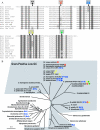A functional homing endonuclease in the Bacillus anthracis nrdE group I intron
- PMID: 17496101
- PMCID: PMC1951841
- DOI: 10.1128/JB.00234-07
A functional homing endonuclease in the Bacillus anthracis nrdE group I intron
Abstract
The essential Bacillus anthracis nrdE gene carries a self-splicing group I intron with a putative homing endonuclease belonging to the GIY-YIG family. Here, we show that the nrdE pre-mRNA is spliced and that the homing endonuclease cleaves an intronless nrdE gene 5 nucleotides (nt) upstream of the intron insertion site, producing 2-nt 3' extensions. We also show that the sequence required for efficient cleavage spans at least 4 bp upstream and 31 bp downstream of the cleaved coding strand. The position of the recognition sequence in relation to the cleavage position is as expected for a GIY-YIG homing endonuclease. Interestingly, nrdE genes from several other Bacillaceae were also susceptible to cleavage, with those of Bacillus cereus, Staphylococcus epidermidis (nrdE1), B. anthracis, and Bacillus thuringiensis serovar konkukian being better substrates than those of Bacillus subtilis, Bacillus lichenformis, and S. epidermidis (nrdE2). On the other hand, nrdE genes from Lactococcus lactis, Escherichia coli, Salmonella enterica serovar Typhimurium, and Corynebacterium ammoniagenes were not cleaved. Intervening sequences (IVSs) residing in protein-coding genes are often found in enzymes involved in DNA metabolism, and the ribonucleotide reductase nrdE gene is a frequent target for self-splicing IVSs. A comparison of nrdE genes from seven gram-positive low-G+C bacteria, two bacteriophages, and Nocardia farcinica showed five different insertion sites for self-splicing IVSs within the coding region of the nrdE gene.
Figures






Similar articles
-
Unconventional GIY-YIG homing endonuclease encoded in group I introns in closely related strains of the Bacillus cereus group.Nucleic Acids Res. 2008 Jan;36(1):300-10. doi: 10.1093/nar/gkm1016. Epub 2007 Nov 21. Nucleic Acids Res. 2008. PMID: 18032435 Free PMC article.
-
The evolution of homing endonuclease genes and group I introns in nuclear rDNA.Mol Biol Evol. 2004 Jan;21(1):129-40. doi: 10.1093/molbev/msh005. Epub 2003 Oct 31. Mol Biol Evol. 2004. PMID: 14595099
-
A free-standing homing endonuclease targets an intron insertion site in the psbA gene of cyanophages.Curr Biol. 2009 Feb 10;19(3):218-22. doi: 10.1016/j.cub.2008.11.069. Curr Biol. 2009. PMID: 19200728
-
Homing endonuclease structure and function.Q Rev Biophys. 2005 Feb;38(1):49-95. doi: 10.1017/S0033583505004063. Epub 2005 Dec 9. Q Rev Biophys. 2005. PMID: 16336743 Review.
-
Group II introns and expression of conjugative transfer functions in lactic acid bacteria.Antonie Van Leeuwenhoek. 1999 Jul-Nov;76(1-4):77-88. Antonie Van Leeuwenhoek. 1999. PMID: 10532373 Review.
Cited by
-
Unconventional GIY-YIG homing endonuclease encoded in group I introns in closely related strains of the Bacillus cereus group.Nucleic Acids Res. 2008 Jan;36(1):300-10. doi: 10.1093/nar/gkm1016. Epub 2007 Nov 21. Nucleic Acids Res. 2008. PMID: 18032435 Free PMC article.
-
Learning to live together: mutualism between self-splicing introns and their hosts.BMC Biol. 2011 Apr 11;9:22. doi: 10.1186/1741-7007-9-22. BMC Biol. 2011. PMID: 21481283 Free PMC article. Review.
-
Coevolution of a homing endonuclease and its host target sequence.J Mol Biol. 2007 Oct 5;372(5):1305-19. doi: 10.1016/j.jmb.2007.07.052. Epub 2007 Aug 2. J Mol Biol. 2007. PMID: 17720189 Free PMC article.
-
I-PfoP3I: a novel nicking HNH homing endonuclease encoded in the group I intron of the DNA polymerase gene in Phormidium foveolarum phage Pf-WMP3.PLoS One. 2012;7(8):e43738. doi: 10.1371/journal.pone.0043738. Epub 2012 Aug 27. PLoS One. 2012. PMID: 22952751 Free PMC article.
-
Activity and specificity of the bacterial PD-(D/E)XK homing endonuclease I-Ssp6803I.J Mol Biol. 2009 Feb 6;385(5):1498-510. doi: 10.1016/j.jmb.2008.10.096. Epub 2008 Nov 12. J Mol Biol. 2009. PMID: 19038269 Free PMC article.
References
-
- Cech, T. R. 1990. Self-splicing of group I introns. Annu. Rev. Biochem. 59:543-568. - PubMed
-
- Chen, I., and D. Dubnau. 2004. DNA uptake during bacterial transformation. Nat. Rev. Microbiol. 2:241-249. - PubMed
-
- Claverys, J. P., M. Prudhomme, and B. Martin. 2006. Induction of competence regulons as a general response to stress in gram-positive bacteria. Annu. Rev. Microbiol. 60:451-475. - PubMed
Publication types
MeSH terms
Substances
LinkOut - more resources
Full Text Sources
Molecular Biology Databases
Research Materials

